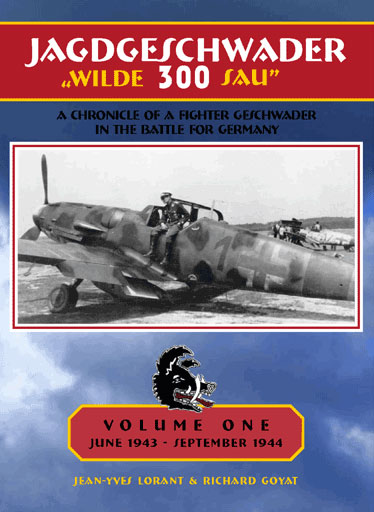|
 Jagdgeschwader
300: A Chronicle of a Fighter Geschwader in the Battle for Germany —
Volume One: June 1943 – September 1944 Jagdgeschwader
300: A Chronicle of a Fighter Geschwader in the Battle for Germany —
Volume One: June 1943 – September 1944
by
Jean-Yves
Lorant & Richard Goyat
Translated
by Neil Page
Illustrated
by Tom Tullis and Richard Goyat
Published by
Eagle Editions Limited
|
S u m m a r y
|
| ISBN: |
0-9761034-0-0 (standard
edition); 0-9761034-1-9 (limited edition) |
| Media and Contents: |
Hard cover with sturdy dust
jacket; four hundred 8.5" x 11" (21.6 cm x 27.9 cm) pages printed on
heavy glossy paper; approximately four hundred photographs, most
previously unpublished; twenty-six color profile paintings. |
| Price: |
US$75.00
(standard edition);
US$165.00 (leather-bound and autographed limited edition);
both available online from Eagle Editions website |
| Review Type: |
FirstRead |
| Advantages: |
Simultaneously provides
historical perspective, day-to-day descriptions of unit engagements,
moving personal accounts by pilots, and detailed coverage of
aircraft subtypes, camouflage and markings. Many photo captions
include comments on camouflage and markings. Very well written,
translated and produced. |
| Disadvantages: |
None |
| Recommendation: |
Highly recommended for Luftwaffe
modelers, aviation historians, and casual readers interested in
World War II. |
Reviewed by Dr. Charles E.Metz
JG 300 was a highly unusual Luftwaffe unit that pioneered the use of
single-seat aircraft in night fighting, served subsequently for nine
months as a front-line nightfighter Geschwader, and then converted
quickly to dayfighting, playing a major role in Reich Defense during the
final year of World War II. Its Messerschmitt 109 and Focke Wulf 190
aircraft wore a great variety of camouflage and markings that make them
exceptionally attractive subjects for modelers. This Geschwader’s
complex story obviously provides fertile ground for a book of potential
interest to a broad audience. However, it also complicates an aspiring
author’s task, not only because of the breadth of material to be
covered, but also because the different expectations of modelers,
historians and casual readers provide so much opportunity for
disappointing at least one of these constituencies. Fortunately for all
of us, Jean-Yves Lorant and Richard Goyat have met the challenge
wonderfully well.
This superbly translated and produced 400-page volume is only the first
half of an effort that may be expected to endure both as the definitive
account of Jagdgeschwader 300 and as a benchmark for future Luftwaffe
unit histories. (Volume Two is scheduled for release before the end of
the year.) However, this book will be not only respected, but also
loved, because it is an eminently readable — often downright exciting —
work that manages simultaneously to provide historical perspective,
day-to-day descriptions of unit engagements, moving personal accounts by
pilots, and detailed coverage of aircraft subtypes, camouflage and
markings. Its approximately four hundred photographs are well
reproduced, though the image quality of a few is necessarily limited by
that of the original prints or negatives. Most of these photos have not
been published previously, and all are exceptionally well captioned,
often with carefully-considered comments on camouflage and markings.
The book is comprised of ten chapters that begin with a brief overview
of nightfighting in the early phases of WW II, proceed through the
foundation of Geschwader Hermann and its transformation into JG 300, and
end four months after the unit’s conversion to the dayfighter role in
May of 1944. The text and photos are complemented by an intriguing
Introduction on the Luftwaffe’s criteria for acceptance of victory
claims, numerous footnotes — more than a hundred in Chapter Ten alone! —
that provide helpful detail without detracting from the flow of the
narrative, twenty-six color profiles by Tom Tullis, two fly-leaf
paintings by co-author Richard Goyat, seven appendices, and a detailed
eight-page index. All of the color profiles are documented by
photographs, and some of the camouflage and marking schemes that they
portray are both surprising and spectacular. Eagle Editions is releasing
decals for approximately half of these aircraft, the profiles of which
can be seen at
http://www.eagle-editions.com/decal88.htm ,
http://www.eagle-editions.com/decal89.htm and
http://www.eagle-editions.com/decal90.htm .
A marvelously successful example of multi-tasking, this book is highly
recommended for Luftwaffe modelers, aviation historians, and casual
readers interested in World War II.
Thanks to
Eagle Editions for
the review sample.
Augsburg's Last Eagles is
available direct from
Eagle Editions website or specialist bookstores

Review Copyright © 2005 by
Dr. Charles E. Metz
This Page Created on 19 July, 2005
Last updated
19 July, 2005
Back to
HyperScale Main Page
Back to
Reviews Page |
Home | What's
New | Features
| Gallery |
Reviews | Reference
| Forum
| Search